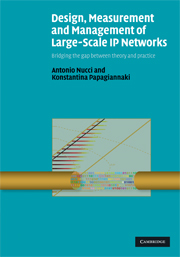 Design, Measurement and Management of Large-Scale IP Networks
Design, Measurement and Management of Large-Scale IP Networks from II - Network design and traffic engineering
Published online by Cambridge University Press: 05 September 2012
The Internet is made of many separate routing domains called Autonomous Systems (ASs), each of which runs an IGP such as IS–IS or OSPF. The IGP handles routes to destinations within the AS, but does not calculate routes beyond the AS boundary. Internet Gateway Protocol engineering (or traffic engineering or IGP optimization) is the tuning of local IS–IS or OSPF metrics to improve performance within the AS. Today, IGP engineering is an ad-hoc process where metric tuning is performed by each AS in isolation. That is, each AS optimizes paths within its local network for traffic traversing it without coordinating these changes with neighboring ASs. The primary assumption behind such an assertion is that there is sufficient separation between intra-domain and inter-domain routing.
Beyond the AS boundary, the choice of AS hops is determined by the BGP,; BGP engineering is a less developed and less understood process compared to IGP engineering. In addition to whether there is a physical link between two ASs over which routes and traffic can flow, there are several BGP policies that determine which inter-domain paths are exposed to a neighboring AS. Business peering policies can directly translate into which routes are exported to each AS. After all these policies are applied, the remaining feasible paths are subjected to the “hot-potato” routing policy. Hot-potato routing occurs when there are multiple egress points to reach a destination.
To save this book to your Kindle, first ensure [email protected] is added to your Approved Personal Document E-mail List under your Personal Document Settings on the Manage Your Content and Devices page of your Amazon account. Then enter the ‘name’ part of your Kindle email address below. Find out more about saving to your Kindle.
Note you can select to save to either the @free.kindle.com or @kindle.com variations. ‘@free.kindle.com’ emails are free but can only be saved to your device when it is connected to wi-fi. ‘@kindle.com’ emails can be delivered even when you are not connected to wi-fi, but note that service fees apply.
Find out more about the Kindle Personal Document Service.
To save content items to your account, please confirm that you agree to abide by our usage policies. If this is the first time you use this feature, you will be asked to authorise Cambridge Core to connect with your account. Find out more about saving content to Dropbox.
To save content items to your account, please confirm that you agree to abide by our usage policies. If this is the first time you use this feature, you will be asked to authorise Cambridge Core to connect with your account. Find out more about saving content to Google Drive.